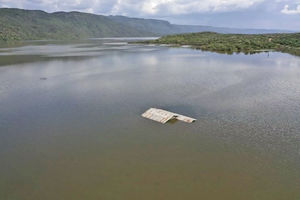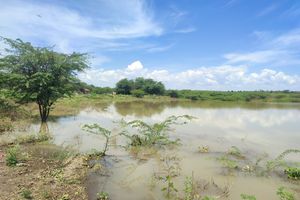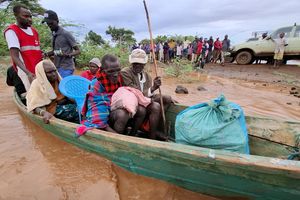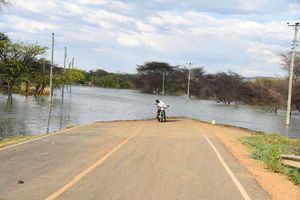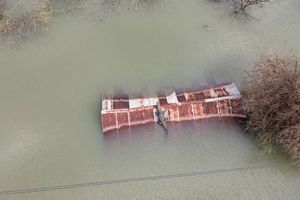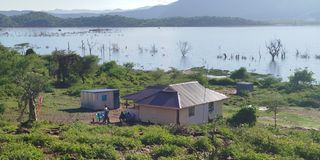
Some houses built near the shores of Lake Bogoria.
In 2013, Fredrick Kibon from Kaptelin village in Baringo County was forced out of his home by rising water levels in Lake Bogoria and had to relocate to safer ground.
At the time, more than 14 acres of his maize and tomato farm under irrigation and contracted by the Kenya Seed Company were swallowed by the lake's floodwaters.
With nowhere else to go, Mr Kibon dismantled the iron sheets from the marooned structures that housed his two wives and nine children and used them to build new houses adjacent to the swollen lake.
But in 2021, the lake rose again exponentially marooning his home and forcing him to relocate for a second time.
“Since I don’t have anywhere else to go, I had to build my house just next to the lake. My land is now nearly a kilometre inside the water and the lake shows no sign of receding as it keeps growing even when there is no rain,” he added.
He raised concerns about their current living conditions, saying that the nearby Lake Bogoria National Reserve has many wild animals and this has led to many encounters with wild animals.
“Water has moved so close to our houses that snakes, crocodiles and hippos now roam our compounds. My elderly mother is currently nursing a snake bite she suffered while sleeping. It’s dangerous, but we have no choice,” he said.
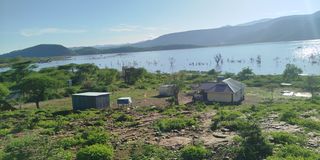
Some houses built near the shores of Lake Bogoria.
Mr Kibon’s plight mirrors that of other displaced families, many of whom live just next to the lake and move their houses only slightly further away every time the water rises.
“Beyond the displacement, we face many challenges. Between 2021 and 2023 we lost three neighbours. We had no land to bury them because we are squatting. One body was almost buried in a public cemetery in Kabarnet before a kind neighbour offered a piece of land for the burial,” he said.
Mr Kibon said that 53 displaced families hold title deeds yet none have been compensated despite numerous pleas to both the national and county governments.
“It is only fair for the government to give us alternative land. We cannot keep moving endlessly as we had legal ownership of the land swallowed by the lake,” he said.
Before the displacement, Mr Kibon relied on irrigation farming to support his family. Now, he depends on well-wishers. “I can’t even burn charcoal for income because I’m squatting on public land,” he lamented.
Eighty-two-year-old Richard Yegon from Loboi village also lost more than 10 acres to the rising waters, which he said is now 10 kilometres inside the lake.
“The flooding in Lake Bogoria is a mystery. We have had heavy rains in the past like in 1961 but they never caused this kind of flooding. Nowadays, the lake rises even when it doesn’t rain,” said Mr Yegon, who has been displaced three times since 1983, most recently in 2020.

Richard Yegon, 82, from Loboi village who has been displaced by the flooding in Lake Bogoria three times. He says his land is now approximately 10 kilometres inside the lake.
“Most of the land that is now submerged used to be farms and homesteads. People are now squatting in shopping centres and snakes have invaded homes,” he added.
Christine Kandie, an official of the Endorois Indigenous Women Empowerment Network, said many structures and homes, including the Loboi Dispensary, have been submerged by the rising waters.
“Families that depended on irrigation and livestock were forced to reduce their herds after grazing land was submerged. Now, many don’t know where their next meal will come from,” she said.
According to Mr James Kimaru, the senior warden at the Lake Bogoria National Reserve, the lake has expanded by more than 10 square kilometres since 2020 from 34 square kilometres in 2019 to over 45 square kilometres today.
The waters have submerged numerous structures, including hotels, roads, homes, and the park's main gate.
“The flooding has negatively impacted tourism. Campsites have been swallowed, roads cut off and the county has had to spend over Sh25 million to construct alternative routes,” he said.
The main gate and administration block, which were built in the 2017/18 financial year at a cost of Sh30 million, are now underwater. A 26-kilometre road inside the reserve, constructed at a cost of Sh15 million, has also been submerged.
“We have lost infrastructure worth over Sh57.5 million, including curio shops and Sh3 million-worth campsites. The flooding continues to affect conservation and tourism efforts,” the warden added.

